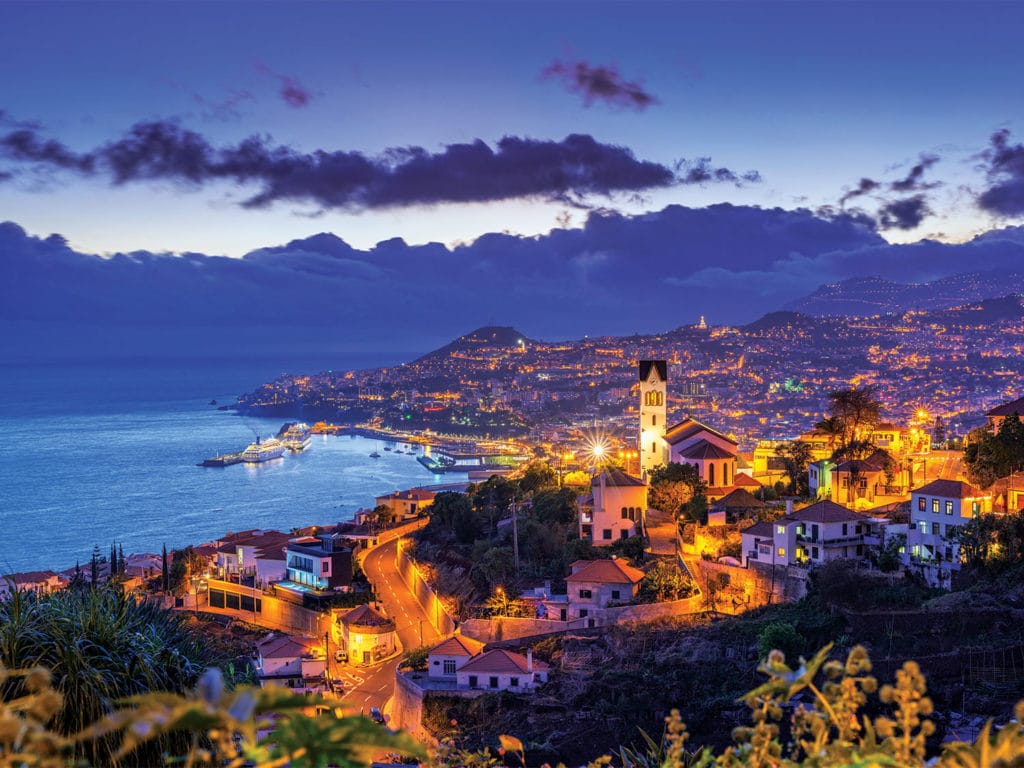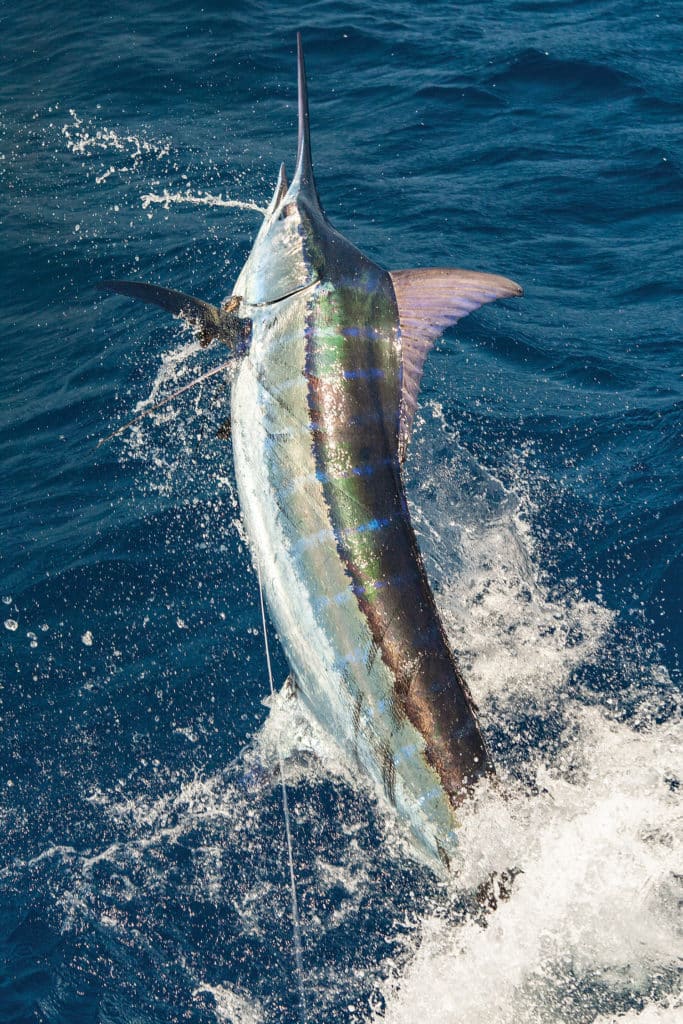
It’s an incredible enigma—unknown even to the experts—why this corner of the Atlantic Ocean produces so many blue marlin over 400 pounds. When you hook a blue off Madeira, the chances are good it will be a big one, perhaps even the fish of a lifetime. The juveniles seem to stay away, so if you’re looking for a true big-fish destination, this is it.
The Magic
What is it about Madeira that makes it so charming? We could start with the magnificent food and world-famous Madeira wines, or just the easygoing ambience of this unique, safe and friendly island. For the average tourist, it’s Portugal’s best-kept secret, but travelers around the world are finally starting to learn more about this amazing destination that is located roughly 400 miles west of Morocco. One group of visitors that has known about this island for quite some time are some of the best big-game fishermen in the world. They have been magnetically drawn to Madeira from far and wide to fish for those big blue marlin in the calm waters surrounding the island.
Word spread like wildfire around the fishing community in the 1990s about the numbers of big Atlantic blues that were turning up during the summer months, and all kinds of amazing feats were unfolding at the time: American angler Stewart Campbell and Frenchman Jean Paul Richard each caught two blues over 1,000 pounds in a single day, and several IGFA line-class world records were also broken. Among those records, Campbell broke the 30-pound-test mark with an 872-pound blue, and lady angler Shelby Rogers from the US broke the women’s 80-pound record with a 1,059-pounder. Laurent Richard, fishing on his father Jean Paul’s French Look, was the first junior angler in the world to boat a grander blue, and Tracy Melton landed a 1,083-pound fish on 80-pound-class stand-up tackle.

Many anglers have boated or released their personal-best blue marlin on their first visits to Madeira, and plenty of stories have been written up in sport-fishing magazines around the world—including this one—about how good those Madeira grounds really were. Some of the world’s best captains—Bark Garnsey, Peter B. Wright, Skip Smith, Olaf Grimkowski, Zak Conde, James Roberts, Clay Hensley and others—were all attracted to the place. They brought with them some of the world’s best wiremen, such as American Charles Perry, Kiwi Marty Bates and Australian Rick Thistlewaite, who wired more black marlin over 1,000 pounds than anyone else on the Great Barrier Reef back in the 1970s, ’80s and ’90s. Don Tyson introduced Thistlewaite to a 1,200-pound blue marlin the first week they fished together in Madeira; Thistlewaite told me later it was the toughest marlin he had ever wired, saying that it nearly broke his back.
The tiny harbor in Funchal was suddenly packed with not only local vessels, but also sport-fishermen from around the world. Campbell had shipped over his vessel, Chunda, and Tyson had Tyson’s Pride, as well as his mothership, Horizons, there. French Look and The Hooker also arrived—all of which provided friendly competition with the two local vessels, Anguilla and Margarita, operated by Capt. Roddy Hays.

Such was the excitement and success around these prolific waters that Wright went through the effort to ship over one of his favorite boats that he often ran off Cairns, Australia: his 40-foot Woodnutt, Duyfken. It was built in Innisfail, just south of Cairns, and was a fish-raising machine on the reef. Duyfken raised plenty of marlin in the Atlantic also, and ended up years later in the Canary Islands, then later in Ghana, where I happened to fish on it one time, catching my biggest blue to date at around 900 pounds.
Legends Among Fishermen
One of the most amazing stories to ever unfold is about a captain drawn to the island from the other side of the world. Australian skipper Peter Bristow arrived in Madeira in 1997. His ability to find and catch giant marlin began back in the early 1970s when he caught 192 black marlin in just two months off Cairns—a record that has never been beaten to this day. One of Bristow’s prominent heavy-tackle anglers was Jo Jo Del Guercio, who caught 13 blacks himself in one day, ranging from 350 to 950 pounds. He also landed 18 granders in just six seasons fishing with Bristow off Cairns. To say they were a formidable team is an understatement.
Bristow had heard about the surge of big blues in Madeira in the early 1990s and was ready for a change of lifestyle after nearly three decades fishing off Cairns and Lizard Island. So he and his English wife, Pepe, decided to move to Europe. Finding a suitable fishing boat in the United Kingdom to take to Madeira proved difficult, until one day, by chance, he located an old 40-foot twin-screw Nelson at an industrial site in a London suburb.

Being a hands-on guy, Bristow converted the retired naval gunboat into a fishing machine by cutting off half the house and extending the cockpit. He rebuilt the tired Perkins V-8 engines and constructed a sturdy fighting chair from scratch, then fitted solid teak coamings for the sturdy heavy-tackle rod holders and purchased a set of outriggers. By leaving the salon bulkhead open, he created a perfect spot for his anglers to watch the spread from two comfortable built-in lounges. Bristow named the vessel Katherine B after his daughter, and shipped the rig to Madeira at the end of 1997.
The old Nelson proved to be a real winner, and at a regular trolling speed of 8 knots, it had a nice, clean wake. Bristow spent the first week playing around with different lures in various spread positions and fine-tuning the rpm on the engines, and those efforts paid off. The first few fish the old girl raised were animals, and one Bristow tagged and released he reckoned was way over 1,000 pounds. A few others were in the 700- to 800-pound range as well. The old marlin captain had found happiness once again.
Since then, Bristow has been chartering Katherine B to clients old and new from around the world, and his success with huge marlin has continued right up to this day. Just turning 81, he probably will go down in the record books for catching more marlin over 1,000 pounds than any other captain in the world. Only Wright beat his tally for grander blacks in Cairns, but when you add up all the giants Bristow has released in Madeira over the years, the numbers would indeed put him over the top. To add to his long and storied fishing career, he was presented with the IGFA’s Tommy Gifford Award in 2019—a well-deserved honor as one of the sport’s top captains.

Madeira Today
Returning home to Australia from my sixth visit to this amazing island in late 2019, I found out the fishing was still very good. I had a couple of days out with Bristow, and we were a bit unlucky, getting five bites, hooking two and tagging only one. The one we released was probably the smallest blue I had ever seen there, but after saying that, it was still a solid 400-pounder. The ones we did miss were much bigger, and one was an easy 900 pounds that nearly spooled us on a 130 before pulling the hook during a series of ballistic jumps.
Between the marinas in Funchal and Calheta, many of the boats chasing big blues will work along the popular fishing grounds of the Cabo Girão cliffs, which are the highest ocean-facing cliff faces in Europe. Over the years, I have been lucky to be around other vessels hooked up on big blues in this area. One battle that comes to mind was watching Stewart Campbell catch a 600-pounder on 12-pound, which they tagged and released. Another incredible and bizarre fight I witnessed was Tracy Melton’s Grander, hooked up to an 800-pounder. Aussie deckie Bo Jenyns and his wife were aboard having a social day out when they hooked the big blue out in deep water. For whatever reason, the marlin headed inshore, and at one stage, all on board could see the big fish swimming along the shallow bottom. Even though the big blue didn’t dive back to really deep water, it still took a couple of hours of hard work on a 130 to get a tag in and release the giant.

Time and Tackle
Another interesting feature when targeting these Madeira blues is the gentleman’s hours everyone fishes. Rarely do the boats leave the dock before 9:00 a.m., and many don’t leave until 10:00. The day usually ends around 5:00 or 6:00 p.m. and the prime time is usually between 11 in the morning until about 4 in the afternoon. From what I’ve experienced and been told by many of the captains fishing there, the marlin bite doesn’t seem to change with the moon phases or tide variations, and all the action I’ve seen has always been around midday to midafternoon.
The charter boats prefer to use heavy bent-butt chair tackle for one simple reason: That grander-plus blue can turn up at any time. Tackle arrangements can be altered by talking to the selected charter-boat captain you choose, and bait-and-switch techniques using lighter tackle can be organized on quite a few of the vessels.
Tournaments and Records
Over the past few decades, Madeira has been extremely popular with anglers fishing the Blue Marlin World Cup each year on the Fourth of July, having produced the winning blue marlin six times. In 2016, Mark Rideout weighed a near-grander going 983 pounds, and in the 1990s, Madeira produced winners three years in a row, from 1995 through 1997, with marlin in excess of 650 pounds; one weighed in at 953 pounds.
In 2019, Craig Watson traveled from his home in Melbourne, Australia, to Madeira to fish the World Cup on the 32-foot Luhrs Express Sorted, out of Calheta Harbour. His winning marlin took a liking to one of his Blue Dog lures called the Turtle, and while his 541.2-pounder might have only just cleared the tournament’s 500-pound minimum, it turned out to be the biggest caught anywhere in the world that day, netting Watson a first-place payday of $600,000.

These big marlin grounds remain popular with many of the world’s light-tackle wizards chasing—and losing—world records also. In 2018, the long-standing 20-pound men’s Atlantic blue marlin record was smashed there. American light-tackle specialist Gary Carter, fishing aboard his G&S, Silver-Rod-O, caught an 806-pound fish to best Campbell’s 714-pounder taken off the Ivory Coast in Africa back in 1990.
As with nearly any other fishery, Madeira has its ups and downs. But when the bite is on, the numbers of big Atlantic blues it can produce is simply incredible. Combine the fishery with European hospitality and cuisine, calm seas and a short run to the grounds, and it’s easy to see why this remains one of the world’s best-loved marlin fisheries.
Madeira Charter Fishing
Funchal
- Boca Raton: 31-foot Black Watch, marlincapeverde.com
- Cabo São João: 31-foot Bertram, captdavidfishingmadeira.com
- Katherine B: 40-foot Nelson Mark I/Halmatic, fishmadeira.com
- Lara Jade: 33-foot CyFish by Cygnus Marine
- Margarita: 35-foot Henriques Maine Coaster, nautisantos.com
- Our Mary: 31-foot Allan Hill/Mitchell Mouldings Custom, fishingmadeiraisland.com
Calheta
- Blue Makaira: 34-foot Rodman, atlanticbluemarlin.com
- Dream Catcher: 31-foot Rampage, madeirabiggame.com
- Sorted: 32-foot Luhrs Express, madeiramarlincharters.com







